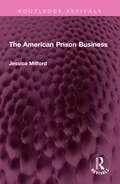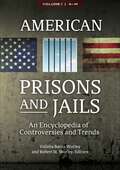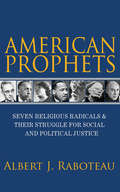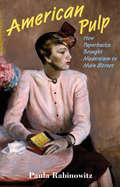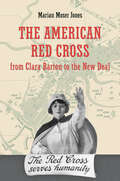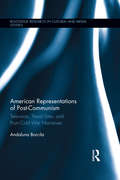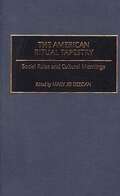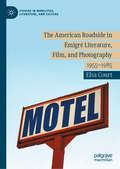- Table View
- List View
The American Prison: Imagining A Different Future
by Francis T. Cullen Cheryl Lero Jonson Mary K. StohrThe American Prison: Issues in Research and Policy (Law, Society and Policy #4)
by Doris LaytonMacKenzie LynneGoodsteinDespite the dire forecasts of others who had themselves edited books, we proceeded with the project of an edited volume on the American prison, although with more than a little trepidation. We had heard the horror stories of authors turning in their chapters months or years late or never at all, of publishers delaying publication dates, of volumes that read more like patchwork quilts than finely loomed cloth. As if to prove the others wrong, our experience in editing this volume has been mar velous, and we think the volume reflects this. Most likely, the success of our experience and of the volume stems from two elements: first, the professionalism and commitment of the authors themselves; and second, the fact that early in the life of this volume, most of the authors convened for a conference to critique and coordinate the chapters. This book brings together an illustrious group of criminologists and correctional scholars who wrote chapters explicitly for this volume. Co hesiveness was furthered by the charge we gave to each author to (1) present the major issues, (2) review the empirical research, and (3) dis cuss the implications of this work for present and future correctional policy. The goal of this project was to examine the major correctional issues facing prison systems. The chapters scrutinize the issues from the perspective of the system and the individual, from theory to practical and daily management problems, from legal to psychological concerns.
The American Prison Business (Routledge Revivals)
by Jessica MitfordFirst published in 1974, The American Prison Business studies the lunacies, the delusions, and the bizarre inner workings of the American prison business. From the first demonstration that the penitentiary is an American invention that was initiated by the late eighteenth-century reformers, to the startling revelations, in the chapter called ‘Cheaper than Chimpanzees’ of how pharmaceutical companies lease prisoners as human guinea-pigs, every page stimulates and surprises the reader as Jessica Mitford describes, inter alia the chemical, surgical and psychiatric techniques used to help ‘violent’ prisoners to be ‘reborn’; why businessmen tend to be more enthusiastic than the prisoners they employ in the ‘rent-a-con’ plan; and the Special Isolation Diet which tastes like inferior dog food. Jessica Mitford’s financial analysis of the prison business is a scoop. Her hard-eyed examination of how parole really works is a revelation. As the prison abolition movement continues to gain momentum, this book will provide food for thought for legislators, officials and students of sociology, law, criminology, penology, and history.
The American Prison Business (Routledge Revivals)
by Jessica MitfordFirst published in 1974, The American Prison Business studies the lunacies, the delusions, and the bizarre inner workings of the American prison business. From the first demonstration that the penitentiary is an American invention that was initiated by the late eighteenth-century reformers, to the startling revelations, in the chapter called ‘Cheaper than Chimpanzees’ of how pharmaceutical companies lease prisoners as human guinea-pigs, every page stimulates and surprises the reader as Jessica Mitford describes, inter alia the chemical, surgical and psychiatric techniques used to help ‘violent’ prisoners to be ‘reborn’; why businessmen tend to be more enthusiastic than the prisoners they employ in the ‘rent-a-con’ plan; and the Special Isolation Diet which tastes like inferior dog food. Jessica Mitford’s financial analysis of the prison business is a scoop. Her hard-eyed examination of how parole really works is a revelation. As the prison abolition movement continues to gain momentum, this book will provide food for thought for legislators, officials and students of sociology, law, criminology, penology, and history.
American Prisons: Their Past, Present and Future
by David Musick Kristine Gunsaulus-MusickImprisonment has become big business in the United States. Using a "history of ideas" approach, this book examines the cultural underpinnings of prisons in the United States and explores how shared ideas about imprisonment evolve into a complex, loosely connected nationwide system of prisons that keeps enough persons to populate a small nation behind bars, razor wire and electrified fences. Tracing both the history of the prison and the very idea of imprisonment in the United States, this book provides students with a critical overview of American prisons and considers their past, their present and directions for the future. Topics covered include: • a history of imprisonment in America from 1600 to the present day; • the twentieth-century prison building binge; • the relationship between U.S. prisons and the private sector; • a critical account of capital punishment; • less-visible prison minorities, including women, children and the elderly; and • sex, violence and disease in prison. This comprehensive book is essential reading for advanced courses on corrections and correctional management and offers a compelling and provocative analysis of the realities of American penal culture from past to present. It is perfect reading for students of criminal justice, corrections, penology and the sociology of punishment.
American Prisons: Their Past, Present and Future
by David Musick Kristine Gunsaulus-MusickImprisonment has become big business in the United States. Using a "history of ideas" approach, this book examines the cultural underpinnings of prisons in the United States and explores how shared ideas about imprisonment evolve into a complex, loosely connected nationwide system of prisons that keeps enough persons to populate a small nation behind bars, razor wire and electrified fences. Tracing both the history of the prison and the very idea of imprisonment in the United States, this book provides students with a critical overview of American prisons and considers their past, their present and directions for the future. Topics covered include: • a history of imprisonment in America from 1600 to the present day; • the twentieth-century prison building binge; • the relationship between U.S. prisons and the private sector; • a critical account of capital punishment; • less-visible prison minorities, including women, children and the elderly; and • sex, violence and disease in prison. This comprehensive book is essential reading for advanced courses on corrections and correctional management and offers a compelling and provocative analysis of the realities of American penal culture from past to present. It is perfect reading for students of criminal justice, corrections, penology and the sociology of punishment.
American Prisons and Jails [2 volumes]: An Encyclopedia of Controversies and Trends [2 volumes]
by Vidisha Barua Worley and Robert M. WorleyThis two-volume encyclopedia provides a comprehensive and authoritative examination of the history and current character of American prisons and jails and their place in the U.S. corrections system.This encyclopedia provides a rigorous and comprehensive summary of correctional systems and practices and their evolution throughout US history.Topics include sentencing norms and contemporary developments; differences between local jails and prisons and regional, state, and federal systems; violent and nonviolent inmate populations; operations of state and federal prisons, including well-known prisons such as ADX-Florence, Alcatrez, Attica, Leavenworth, and San Quentin; privately run, for-profit prisons as well as the companies that run them; inmate culture, including prisoner-generated social hierarchies, prisoner slang, gangs, drug use, and violence; prison trends and statistics, including racial, ethnic, age, gender, and educational breakdowns; the death penalty; and post-incarceration outcomes, including recidivism.The set showcases contributions from some of the leading scholars in the fields of correctional systems and practices and will be a valuable resource for anyone interested in learning more about American prisons, jails, and community corrections.
American Prisons and Jails [2 volumes]: An Encyclopedia of Controversies and Trends [2 volumes]
This two-volume encyclopedia provides a comprehensive and authoritative examination of the history and current character of American prisons and jails and their place in the U.S. corrections system.This encyclopedia provides a rigorous and comprehensive summary of correctional systems and practices and their evolution throughout US history.Topics include sentencing norms and contemporary developments; differences between local jails and prisons and regional, state, and federal systems; violent and nonviolent inmate populations; operations of state and federal prisons, including well-known prisons such as ADX-Florence, Alcatrez, Attica, Leavenworth, and San Quentin; privately run, for-profit prisons as well as the companies that run them; inmate culture, including prisoner-generated social hierarchies, prisoner slang, gangs, drug use, and violence; prison trends and statistics, including racial, ethnic, age, gender, and educational breakdowns; the death penalty; and post-incarceration outcomes, including recidivism.The set showcases contributions from some of the leading scholars in the fields of correctional systems and practices and will be a valuable resource for anyone interested in learning more about American prisons, jails, and community corrections.
The American Professor Pundit: Academics in the World of US Political Media
by Brian R. Calfano Valerie Martinez-Ebers Aida RamusovicThis book considers the production of political media content from the perspective of academics who are increasingly asked to join the ranks of voices charged with informing the public. The work draws on the authors’ first-hand experience and relationships with media reporters, managers, producers, and academics offering their expertise to a wide array of media outlets to understand and report on the dynamics shaping how the academic voice in political news may be at its most useful. Featured prominently in the book is the trade-off between a conventional form of political punditry, which is often characterized by partisan rancour, and a more analytical, theoretical, and/or policy-based approach to explaining politics to both general and diverse audiences. Along the way, the work draws on original survey, in-depth interview, and experimental data to garner insights on what academics in media, reporters, and media managers perceive are the appropriate roles for academics featured in political media. This book also contains relevant technical tips for effective media communication by academics.
American Progress: Nerdkultur, akrobatische Komik und Commedia dell'arte (Serienkulturen: Analyse – Kritik – Bedeutung)
by Holger SchulzeDie Serie 30Rock wälzt die medialen Erzählungen ihrer Epoche (und der Serie selbst) unaufhörlich um: in bislang sieben Staffeln, 140 Episoden, von 30 Autoren für 14 SchauspielerInnen geschrieben – rund um die Erfinderin und Hauptdarstellerin Tina Fey. Dieser Band untersucht die überdrehte Gegenwartsdystopie, ihre Erzählungen, Bühnen und Personen. Markante Episoden werden im Zusammenhang zeitgenössischer Pop- und TV-Kultur untersucht und einzelne ProtagonistInnen in ihrem medialen Handeln und dessen Referenzen. Ein Tableau der Medien- und der Nerdkultur sowie der politischen Agitation entsteht in Form von akrobatischer Komik und Celebrityobsession: eine Form der Commedia dell'arte über den American Progress.
American Prophets: Seven Religious Radicals and Their Struggle for Social and Political Justice
by Albert J. RaboteauAmerican Prophets sheds critical new light on the lives and thought of seven major prophetic figures in twentieth-century America whose social activism was motivated by a deeply felt compassion for those suffering injustice.In this compelling and provocative book, acclaimed religious scholar Albert Raboteau tells the remarkable stories of Abraham Joshua Heschel, A. J. Muste, Dorothy Day, Howard Thurman, Thomas Merton, Martin Luther King, Jr., and Fannie Lou Hamer—inspired individuals who succeeded in conveying their vision to the broader public through writing, speaking, demonstrating, and organizing. Raboteau traces how their paths crossed and their lives intertwined, creating a network of committed activists who significantly changed the attitudes of several generations of Americans about contentious political issues such as war, racism, and poverty. Raboteau examines the influences that shaped their ideas and the surprising connections that linked them together. He discusses their theological and ethical positions, and describes the rhetorical and strategic methods these exemplars of modern prophecy used to persuade their fellow citizens to share their commitment to social change.A momentous scholarly achievement as well as a moving testimony to the human spirit, American Prophets represents a major contribution to the history of religion in American politics. This book is essential reading for anyone who is concerned about social justice, or who wants to know what prophetic thought and action can mean in today's world.
American Prophets: Seven Religious Radicals and Their Struggle for Social and Political Justice
by Albert J. RaboteauAmerican Prophets sheds critical new light on the lives and thought of seven major prophetic figures in twentieth-century America whose social activism was motivated by a deeply felt compassion for those suffering injustice.In this compelling and provocative book, acclaimed religious scholar Albert Raboteau tells the remarkable stories of Abraham Joshua Heschel, A. J. Muste, Dorothy Day, Howard Thurman, Thomas Merton, Martin Luther King, Jr., and Fannie Lou Hamer—inspired individuals who succeeded in conveying their vision to the broader public through writing, speaking, demonstrating, and organizing. Raboteau traces how their paths crossed and their lives intertwined, creating a network of committed activists who significantly changed the attitudes of several generations of Americans about contentious political issues such as war, racism, and poverty. Raboteau examines the influences that shaped their ideas and the surprising connections that linked them together. He discusses their theological and ethical positions, and describes the rhetorical and strategic methods these exemplars of modern prophecy used to persuade their fellow citizens to share their commitment to social change.A momentous scholarly achievement as well as a moving testimony to the human spirit, American Prophets represents a major contribution to the history of religion in American politics. This book is essential reading for anyone who is concerned about social justice, or who wants to know what prophetic thought and action can mean in today's world.
American Proverbs About Women: A Reference Guide (Non-ser.)
by Lois KerschenProverbs supposedly contain the wisdom of the common folk—eternal truths to be passed down through the ages. They are short, often humorous, expressions that teach lessons or give practical advice, and they are perhaps the best indicators of attitudes and beliefs of any form of folklore. Not only reflecting culture, proverbs also perpetuate the cultural dictates of the past, including the fears, prejudices, and misconceptions of their predominately male authors. Because they are generalizations, proverbs sometimes impede accurate observation and analysis and stifle original thought. Like many other traditions and cultural practices, proverbs often promote misleading stereotypes of women. This reference book collects more than 800 American proverbs about women and analyzes their significance.The volume begins with introductory chapters that explore the relationship between proverbs and culture and the image of women presented in proverbs. The chapters that follow are devoted to particular categories, such as wives and 6~rriage, mothers and daughters, women as property, and old women and grandmothers. Each chapter includes a brief introductory overview and a listing of proverbs relating to the topic. The proverbs were gathered through an extensive review of journal articles, proverb dictionaries, and other literature. In addition to true proverbs, the volume includes some phrases, sayings, and proverbial comparisons. Not included are expressions that contain words like mother or daughter but do not really describe women or comment about them. The book then presents a concluding analysis of how American proverbs portray women, an alphabetical index of proverbs, and an extensive bibliography.
American Pulp: How Paperbacks Brought Modernism to Main Street (PDF)
by Paula Rabinowitz"There is real hope for a culture that makes it as easy to buy a book as it does a pack of cigarettes."—a civic leader quoted in a New American Library ad (1951)American Pulp tells the story of the midcentury golden age of pulp paperbacks and how they brought modernism to Main Street, democratized literature and ideas, spurred social mobility, and helped readers fashion new identities. Drawing on extensive original research, Paula Rabinowitz unearths the far-reaching political, social, and aesthetic impact of the pulps between the late 1930s and early 1960s.Published in vast numbers of titles, available everywhere, and sometimes selling in the millions, pulps were throwaway objects accessible to anyone with a quarter. Conventionally associated with romance, crime, and science fiction, the pulps in fact came in every genre and subject. American Pulp tells how these books ingeniously repackaged highbrow fiction and nonfiction for a mass audience, drawing in readers of every kind with promises of entertainment, enlightenment, and titillation. Focusing on important episodes in pulp history, Rabinowitz looks at the wide-ranging effects of free paperbacks distributed to World War II servicemen and women; how pulps prompted important censorship and First Amendment cases; how some gay women read pulp lesbian novels as how-to-dress manuals; the unlikely appearance in pulp science fiction of early representations of the Holocaust; how writers and artists appropriated pulp as a literary and visual style; and much more. Examining their often-lurid packaging as well as their content, American Pulp is richly illustrated with reproductions of dozens of pulp paperback covers, many in color.A fascinating cultural history, American Pulp will change the way we look at these ephemeral yet enduringly intriguing books.
American Radio in China: International Encounters with Technology and Communications, 1919-41 (Palgrave Studies in the History of the Media)
by Michael A. KryskoInterwar era efforts to expand US radio into China floundered in the face of flawed US policies and approaches. Situated at the intersection of media studies, technology studies, and US foreign relations, this study frames the ill-fated radio initiatives as symptomatic of an increasingly troubled US-East Asian relationship before the Pacific War.
The American Red Cross from Clara Barton to the New Deal
by Marian Moser JonesIn dark skirts and bloodied boots, Clara Barton fearlessly ventured on to Civil War battlefields to tend to wounded soldiers. She later worked with civilians in Europe during the Franco-Prussian War, lobbied legislators to ratify the Geneva conventions, and founded and ran the American Red Cross. The American Red Cross from Clara Barton to the New Deal tells the story of the charitable organization from its start in 1881, through its humanitarian aid during wars, natural disasters, and the Depression, to its relief efforts of the 1930s.Marian Moser Jones illustrates the tension between the organization's founding principles of humanity and neutrality and the political, economic, and moral pressures that sometimes caused it to favor one group at the expense of another. This expansive book narrates the stories of: • U.S. natural disasters such as the Jacksonville yellow fever epidemic of 1888, the Sea Islands hurricane of 1893, and the 1906 San Francisco earthquake• crises abroad, including the 1892 Russian famine and the Armenian massacres of 1895–96• efforts to help civilians affected by the civil war in Cuba• power struggles within the American Red Cross leadership and subsequent alliances with the American government• the organization's expansion during World War I• race riots in East St. Louis, Chicago, and Tulsa between 1917 and 1921• help for African American and white Southerners after the Mississippi flood of 1927• relief projects during the Dust Bowl and after the New DealAn epilogue relates the history of the American Red Cross since the beginning of World War II and illuminates the organization's current practices as well as its international reputation.
American Regional Folklore: A Sourcebook and Research Guide
by Terry Ann Mood-LeopoldAn easy-to-use guide to American regional folklore with advice on conducting research, regional essays, and a selective annotated bibliography.American Regional Folklore begins with a chapter on library research, including how to locate a library suitable for folklore research, how to understand a library's resources, and how to construct a research strategy. Mood also gives excellent advice on researching beyond the library: locating and using community resources like historical societies, museums, fairs and festivals, storytelling groups, local colleges, newspapers and magazines, and individuals with knowledge of the field.The rest of the book is divided into eight sections, each one highlighting a separate region (the Northeast, the South and Southern Highlands, the Midwest, the Southwest, the West, the Northwest, Alaska, and Hawaii). Each regional section contains a useful overview essay, written by an expert on the folklore of that particular region, followed by a selective, annotated bibliography of books and a directory of related resources.
American Representations of Post-Communism: Television, Travel Sites, and Post-Cold War Narratives (Routledge Research in Cultural and Media Studies)
by Andaluna BorcilaWith the televised events of 1989, territories of Eastern and Central Europe that had been marked as impenetrable and inaccessible to the Western gaze exploded into visibility. As the narratives of the Cold War crumbled, new narratives emerged and new geographies were produced on and by American television. Using an understudied archive of American news broadcasts, and tracing their flashes and echoes through travel guides and narratives of return written by Eastern European-Americans, this book explores American ways of seeing and mapping communism’s disintegration and the narratives articulated around post-communist sites and subjects.
American Representations of Post-Communism: Television, Travel Sites, and Post-Cold War Narratives (Routledge Research in Cultural and Media Studies)
by Andaluna BorcilaWith the televised events of 1989, territories of Eastern and Central Europe that had been marked as impenetrable and inaccessible to the Western gaze exploded into visibility. As the narratives of the Cold War crumbled, new narratives emerged and new geographies were produced on and by American television. Using an understudied archive of American news broadcasts, and tracing their flashes and echoes through travel guides and narratives of return written by Eastern European-Americans, this book explores American ways of seeing and mapping communism’s disintegration and the narratives articulated around post-communist sites and subjects.
American Revenge Narratives: A Collection of Critical Essays
by Kyle WigginsAmerican Revenge Narratives critically examines the nation’s vengeful storytelling tradition. With essays on late twentieth and twenty-first century fiction, film, and television, it maps the coordinates of the revenge genre’s contemporary reinvention across American culture. By surveying American revenge narratives, this book measures how contemporary payback plots appraise the nation’s political, social, and economic inequities. The volume’s essays collectively make the case that retribution is a defining theme of post-war American culture and an artistic vehicle for critique. In another sense, this book presents a scholarly coming to terms with the nation’s love for vengeance. By investigating recent iterations of an ancient genre, contributors explore how the revenge narrative evolves and thrives within American literary and filmic imagination. Taken together, the book’s diverse chapters attempt to understand American culture’s seemingly inexhaustible production of vengeful tales.
American Revolutions in the Digital Age
by Ben Wright Mark Boonshoft Nora SlonimskyThe interdisciplinary essays in American Revolutions in the Digital Age explore what digital tools can tell us about the late eighteenth- and early nineteenth-century United States and reveal how an understanding of the American past can make sense of our digital present. By employing a host of innovative digital research methods, these authors challenge long-held assumptions about the American past. In addition, this collection uniquely demonstrates how contemporary anxieties about an array of topics, including media disinformation, patriarchy, economic inequality, and public memory, can be better understood through careful considerations of early American history.Open Access edition funded by Iona University
The American Ritual Tapestry: Social Rules and Cultural Meanings (Controversies in Science)
by Mary Jo DeeganAmerican rituals are vital to the creation and renewal of cultural meanings and rules for social interaction. These rituals are rooted in tradition yet are rapidly changing: a contradiction of hyper-modern society. This phenomenon was first explored by Professor Deegan in her 1989 study American Ritual Dramas. The theory examines both participatory rituals and mass-media rituals to show how everyday people become attached to and alienated from other rituals. Elaborating on the critical dramaturgy theory, the essays in this collection show how patterns can be changed to create a more emancipatory and celebratory society.The topics covered in the collection include an analysis of Santa Claus, skinheads, hate crimes, and strip dancing, among other topics. Each contributor has participated in these rituals and many examine related cultural artifacts such as music, brochures, and so forth. As the essays show, postmodern theory has gratly underestimated the power and coherence of these events. An important study for scholars and other researchers involved with sociological theory, social psychology, and popular culture.
The American Roadside in Émigré Literature, Film, and Photography: 1955–1985 (Studies in Mobilities, Literature, and Culture)
by Elsa CourtThe American Roadside in Émigré Literature, Film, and Photography: 1955–1985 traces the origin of a postmodern iconography of mobile consumption equating roadside America with an authentic experience of the United States through the postwar road narrative, a narrative which, Elsa Court argues, has been shaped by and through white male émigré narratives of the American road, in both literature and visual culture. While stressing that these narratives are limited in their understanding of the processes of exclusion and unequal flux in experiences of modern automobility, the book works through four case studies in the American works of European-born authors Vladimir Nabokov, Robert Frank, Alfred Hitchcock, and Wim Wenders to unveil an early phenomenology of the postwar American highway, one that anticipates the works of late-twentieth-century spatial theorists Jean Baudrillard, Michel Foucault, and Marc Augé and sketches a postmodern aesthetic of western mobility and consumption that has become synonymous with contemporary America.
American Routes: Racial Palimpsests and the Transformation of Race
by Angel Adams ParhamAmerican Routes provides a comparative and historical analysis of the migration and integration of white and free black refugees from nineteenth century St. Domingue/Haiti to Louisiana and follows the progress of their descendants over the course of two hundred years. The refugees reinforced Louisiana's tri-racial system and pushed back the progress of Anglo-American racialization by several decades. But over the course of the nineteenth century, the ascendance of the Anglo-American racial system began to eclipse Louisiana's tri-racial Latin/Caribbean system. The result was a racial palimpsest that transformed everyday life in southern Louisiana. White refugees and their descendants in Creole Louisiana succumbed to pressure to adopt a strict definition of whiteness as purity that conformed to standards of the Anglo-American racial system. Those of color, however, held on to the logic of the tri-racial system which allowed them to inhabit an intermediary racial group that provided a buffer against the worst effects of Jim Crow segregation. The St. Domingue/Haiti migration case foreshadows the experiences of present-day immigrants of color from Latin-America and the Caribbean, many of whom chafe against the strictures of the binary U.S. racial system and resist by refusing to be categorized as either black or white. The St. Domingue/Haiti case study is the first of its kind to compare the long-term integration experiences of white and free black nineteenth century immigrants to the U.S. In this sense, it fills a significant gap in studies of race and migration which have long relied on the historical experience of European immigrants as the standard to which all other immigrants are compared.
American Routes: Racial Palimpsests and the Transformation of Race
by Angel Adams ParhamAmerican Routes provides a comparative and historical analysis of the migration and integration of white and free black refugees from nineteenth century St. Domingue/Haiti to Louisiana and follows the progress of their descendants over the course of two hundred years. The refugees reinforced Louisiana's tri-racial system and pushed back the progress of Anglo-American racialization by several decades. But over the course of the nineteenth century, the ascendance of the Anglo-American racial system began to eclipse Louisiana's tri-racial Latin/Caribbean system. The result was a racial palimpsest that transformed everyday life in southern Louisiana. White refugees and their descendants in Creole Louisiana succumbed to pressure to adopt a strict definition of whiteness as purity that conformed to standards of the Anglo-American racial system. Those of color, however, held on to the logic of the tri-racial system which allowed them to inhabit an intermediary racial group that provided a buffer against the worst effects of Jim Crow segregation. The St. Domingue/Haiti migration case foreshadows the experiences of present-day immigrants of color from Latin-America and the Caribbean, many of whom chafe against the strictures of the binary U.S. racial system and resist by refusing to be categorized as either black or white. The St. Domingue/Haiti case study is the first of its kind to compare the long-term integration experiences of white and free black nineteenth century immigrants to the U.S. In this sense, it fills a significant gap in studies of race and migration which have long relied on the historical experience of European immigrants as the standard to which all other immigrants are compared.


